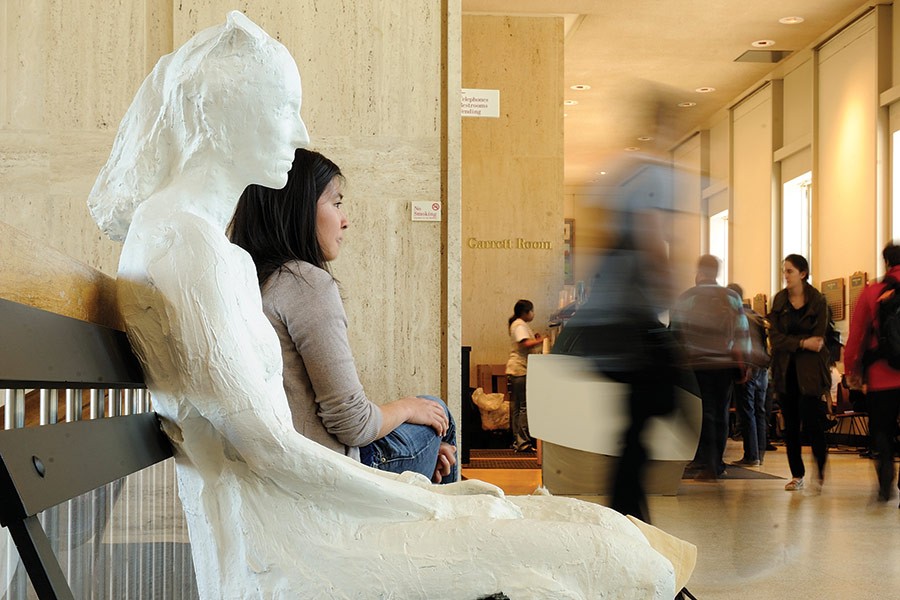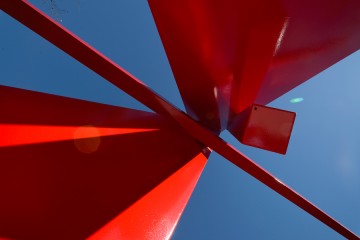Back in 2004, a university committee took a bit of a left turn as it got to work. Composed of students, faculty, and trustees, the Homewood Arts Task Force started out evaluating proposals to expand classes and boost performance and exhibit opportunities for arts-minded students.
"The students on that committee were the ones who moved the conversation, and they moved it toward the fact that they wanted a campus environment where they were surrounded by art," says Winston Tabb, Sheridan Dean of University Libraries and Museums and the chair of that task force. "They didn't want it done in a museumlike way. They wanted art that would be an integral and natural part of their day-to-day life on campus."
Today, Tabb can see tangible evidence that this vision is becoming a reality. Every morning when he enters the Eisenhower Library, he walks past Woman With Sunglasses on Bench, a sculpture by George Segal that arrived in 2009 via a gift from the Donna and Carroll Janis family.
"It's been such a popular piece," Tabb says. "Students sit there on the bench, right next to her. They have conversations around her, two students sitting on either side. I've seen fresh-cut flowers in her hands. One day I came in and someone had their laptop resting in her lap."
The Segal sculpture is one of seven major works of art that have arrived on the Homewood campus in recent years, and more are in the works. Over time, the vision of the arts task force has evolved into a robust Public Art Program that includes an Art Review Panel charged with selecting pieces and an initiative that, as part of the university's current Rising to the Challenge fundraising campaign, aims to raise funds for the purchase, installation, and maintenance of works of art throughout the Homewood campus.
"We're still in the beginning phase of this effort," says Constance Caplan, a university trustee emerita and an art collector, who has been advising the program and has been invited to join the Art Review Panel. "It will take us a number of years to reach our full goals."
Caplan recently announced plans to make a personal contribution to the cause. She has bequeathed to the university Pink Flamingos, a steel sculpture by Richard Serra that now stands on the lawn of her home in the north suburbs of Baltimore.
"I've always been interested in the beautiful architecture and art of the Homewood campus, and I've always thought it would be wonderful if there were more public art," says Caplan, who earned her master's degree in political science at Johns Hopkins.
The Public Art Program evolved in step-by-step fashion, focusing at first on laying the foundation for progress. A key early step by the Homewood Arts Task Force was to recommend the creation of a new position, curator of cultural properties, to be housed in the Sheridan Libraries' Special Collections Department.
"You can't in good conscience ask people to donate art or contribute to its acquisition unless you have a plan for taking care of it," Tabb says.
Once the university agreed to establish the new position, Jackie O'Regan, who had been curator of Evergreen Museum & Library, was appointed to the job in 2007. She immediately sensed the excitement that public art could generate on the campus, as artist Kendall Buster was then hard at work on Vessel Field, the dramatic overhead sculpture that now adorns the glass-ceilinged atrium of Gilman Hall.
"That was just so wonderful to see because there was a very committed team involved in planning that commission," O'Regan says. "Nancy Rosen, a New York art consultant, was the curator on this project, and she did just a brilliant job of finding the right artist and doing the project the right way."
In some ways, O'Regan and Tabb were starting from square one. No comprehensive database of artworks on the Homewood campus existed, so O'Regan immediately set out to create one. She and Tabb tasked the seven-member Art Review Panel with developing for the first time a set of formal policies and goals regarding the acquisition and maintenance of public art.
That early work also included teaming up with the trustees' Buildings and Grounds Committee and the university's facilities professionals to identify which locations on campus were appropriate for public art and which were not. Tabb reaches into his files to retrieve a printout of the multicolored map that came out of those meetings. "One important principle that emerged in this was that the wonderful quads on this campus should be left open and unobstructed," he says.
But in other ways, O'Regan and Tabb were able to hit the ground running, thanks in no small part to their ability to access high-powered help. A former chair of the Baltimore Museum of Art board, Caplan is well-connected in the New York art world. It was through one of those connections that sculptor Willem de Kooning's Reclining Figure arrived on campus on long-term loan from the Willem de Kooning Foundation. The piece now sits between Remsen and Dunning halls.
O'Regan and Tabb also were able to tap the expertise of Rosen, the arts adviser to New York City Mayor (and Johns Hopkins alumnus) Michael Bloomberg. In addition to her work on Vessel Field, she has earned widespread plaudits for her work selecting the hundreds of pieces of art that adorn the new Charlotte R. Bloomberg Children's Center on Johns Hopkins' East Baltimore campus.
Of the artworks that have arrived to date at Homewood under the program, most are gifts or long-term loans. Two were commissioned as part of major construction projects, and the university purchased the painting Joan of Arc by Baltimore artist Grace Hartigan, which now hangs in Nichols House, the president's residence.
"Every piece is part of a learning process," O'Regan says. "We find ourselves working with very different artists, different materials, different locations, some inside, some outside. That's what makes the work so enjoyable."
While walking around campus and showing off a few of the recent additions on an October morning, Tabb was a bundle of energy and pride as he encountered each new work.
"I don't know how I ever got into all of this—I'm just a librarian," he says with a mischievous grin. "But we've really had a good time with this program. We've made a lot of progress, and we're all looking forward to what comes next."
Posted in Arts+Culture
Tagged sheridan libraries, visual art, winston tabb, sculpture










